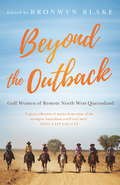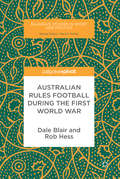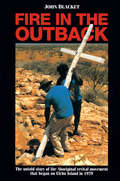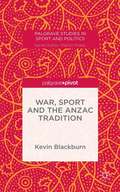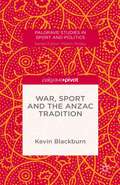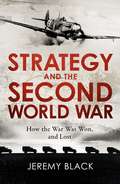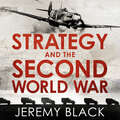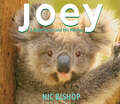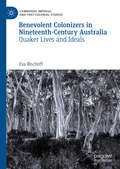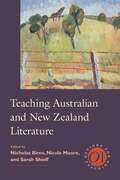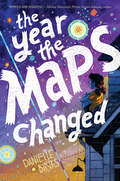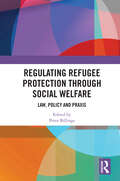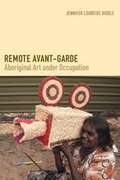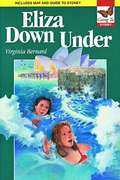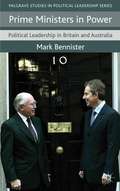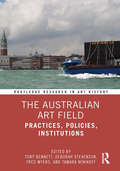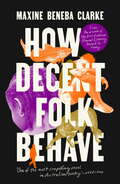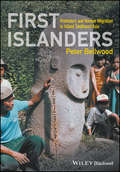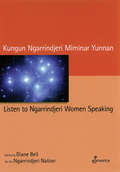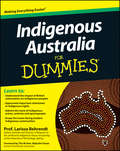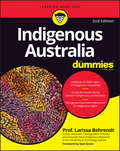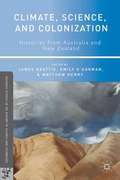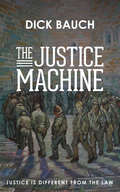- Table View
- List View
Beyond the Outback: Gulf Women of Remote North West Queensland
by Bronwyn BlakeTwenty women share their incredible stories of surviving and thriving in the remote Australian 'Gulf Country', near the Gulf of Carpentaria.Gulf women are self-sufficient, generous, and can cope with almost anything that life and the environment throws at them: floods, drought, sickness, emergencies. Whether they are graziers, fisherwomen, ringers, women in tourism, aviation and education, Indigenous women or descendants from early women settlers, this powerful book gives these women a voice to tell their own stories.There are stories of new mothers on properties isolated and inaccessible for months in the wet season; women giving birth at home with only neighbours to assist; reminiscences from last century and World War II, and accounts of fishing in the Gulf in sometimes unimaginable conditions.From the kids wanting a baby croc for a pet to the terror of a snake bite with a flooded airstrip and impassable roads, these women treat the extraordinary events in their lives as just part of their remote way of life.Set in a world of vast landscapes, distance and merciless climate, Beyond the Outback contains riveting tales of the lives of the women who live, work and raise families in one of Australia's most isolated regions. It will be loved by readers of Sara Henderson, Toni Tapp Coutts and Terry Underwood.
Australian Rules Football During the First World War
by Dale Blair Rob HessThe book explores the intersection between the Great War and patriotism through an examination of the effects of both on Australia’s most popular football code. The work is chronological, and therefore provides an easy path by which events may be followed. Ultimately it seeks to shine a light on and provide considerable detail to a much-ignored period in Australian Rules football history, including women’s football history, that was subject to much upheaval and which reflected considerable social and class divisions in society at the time. One hundred years on, the Australian Football League presents past soldier footballers as unequivocal representatives of a unifying national ‘Anzac’ spirit. That is far from the reality of football’s First World War experience.
A History of Victoria
by Geoffrey BlaineyA History of Victoria is a lively account of the people, places and events that have shaped Victoria, from the arrival of the first Aboriginal peoples through to the present day. In his inimitable style, Geoffrey Blainey considers Victoria's transformation from rural state to urban society. He speculates on the contrasts between Melbourne and Sydney, and describes formative events in Victoria's history, including the exploits of Ned Kelly, the rise of Australian Football and the Olympics of 1956. Melbourne's latest population boom, sprawling suburbs and expanding ethnic communities are explored. Blainey also casts light on Victoria's recent political history. This edition features sections on the Black Saturday bushfires of 2009, the end of the drought and the controversy surrounding the Wonthaggi desalination plant. New illustrations, photographs and maps enrich the narrative. Written by one of Australia's leading historians, this book offers remarkable insight into Victoria's unique position within Australian history.
Fire in the Outback: The untold story of the Aboriginal revival movement that began on Elcho Island in 1979
by John Blacket'A real classic''Every Australian believer should read this book''Australian Aborigines are the most evangelised people in the world with the least developed Christian growth' [Ron Williams, Aboriginal pastor and elder] God took the outcasts - rejected and despised Australian Aborigines - and transformed whole communities in a few days, first on an island in north Australia, and later across the north, centre, west and east of Australia. This fire of revival transformed health, hygiene, attitude to work and education, and brought true reconciliation and love between families, clans and tribes that had been fighting for many generations. Fire in the Outback is the Aborigines' own stories of what happened. It is a very frank, exciting and balanced presentation that challenges our own lives as it looks at the roots, background and results of a revival that points the way for the future. This is the story of real community transformation that produced many of the next generation of indigenous leaders and prepared the way for Australia's first peoples to take their God-given role in real leadership in one of the most multi-cultural nations on earth.
War, Sport and the Anzac Tradition (Palgrave Studies in Sport and Politics)
by Kevin BlackburnWar, Sport and the Anzac Tradition.
War, Sport and the Anzac Tradition (Palgrave Studies in Sport and Politics)
by Kevin BlackburnCommemoration of war is done through sport on Anzac Day to remember Australia's war dead. War, Sport and the Anzac Tradition traces the creation of this sporting tradition at Gallipoli in 1915, and how it has evolved from late Victorian and Edwardian ideas of masculinity extolling prowess on the sports field as fostering prowess on the battlefield.
Strategy and the Second World War: How the War was Won, and Lost
by Jeremy BlackA concise, accessible account of strategy and the Second World War. How the war was won . . . and lost..In 1941, the Second World War became global, when Nazi Germany attacked the Soviet Union; Japan attacked the United States at Pearl Harbor; and Germany declared war on the United States.In this timely book, which fills a real gap, Black engages with the strategic issues of the time - as they developed chronologically, and interacted - and relates these to subsequent debates about the choices made, revealing their continued political resonances.Beginning with Appeasement and the Soviet-German pact as key strategic means, Black examines the consequences of the fall of France for the strategies of all the powers. He shows how Allied strategy-making was more effective at the Anglo-American level than with the Soviet Union, not only for ideological and political reasons, but also because the Americans and British had a better grasp of the global dimension.He explores how German and Japanese strategies evolved as the war went badly for the Axis powers, and discusses the extent to which seeking to mould the post-war world informed Allied strategic choices from 1943 onwards, and the role these played in post-war politics, notably in the Cold War. Strategy was a crucial tool not only for conducting the war; it remains the key to understanding it today.
Strategy and the Second World War: How the War was Won, and Lost
by Jeremy BlackA concise, accessible account of strategy and the Second World War. How the war was won . . . and lost..In 1941, the Second World War became global, when Nazi Germany attacked the Soviet Union; Japan attacked the United States at Pearl Harbor; and Germany declared war on the United States.In this timely book, which fills a real gap, Black engages with the strategic issues of the time - as they developed chronologically, and interacted - and relates these to subsequent debates about the choices made, revealing their continued political resonances.Beginning with Appeasement and the Soviet-German pact as key strategic means, Black examines the consequences of the fall of France for the strategies of all the powers. He shows how Allied strategy-making was more effective at the Anglo-American level than with the Soviet Union, not only for ideological and political reasons, but also because the Americans and British had a better grasp of the global dimension.He explores how German and Japanese strategies evolved as the war went badly for the Axis powers, and discusses the extent to which seeking to mould the post-war world informed Allied strategic choices from 1943 onwards, and the role these played in post-war politics, notably in the Cold War. Strategy was a crucial tool not only for conducting the war; it remains the key to understanding it today.
Strategy and the Second World War: How the War was Won, and Lost
by Jeremy BlackA concise, accessible account of strategy and the Second World War. How the war was won . . . and lost..In 1941, the Second World War became global, when Nazi Germany attacked the Soviet Union; Japan attacked the United States at Pearl Harbor; and Germany declared war on the United States.In this timely book, which fills a real gap, Black engages with the strategic issues of the time - as they developed chronologically, and interacted - and relates these to subsequent debates about the choices made, revealing their continued political resonances.Beginning with Appeasement and the Soviet-German pact as key strategic means, Black examines the consequences of the fall of France for the strategies of all the powers. He shows how Allied strategy-making was more effective at the Anglo-American level than with the Soviet Union, not only for ideological and political reasons, but also because the Americans and British had a better grasp of the global dimension.He explores how German and Japanese strategies evolved as the war went badly for the Axis powers, and discusses the extent to which seeking to mould the post-war world informed Allied strategic choices from 1943 onwards, and the role these played in post-war politics, notably in the Cold War. Strategy was a crucial tool not only for conducting the war; it remains the key to understanding it today.
Joey: A Baby Koala and His Mother
by Nic BishopIt's an exciting morning for Joey the baby koala in this beautifully photographed book from award-winning author Nic Bishop.High above the ground, in the shade of a eucalyptus tree, Joey the baby koala wakes up hungry! Crawling over his sleeping mom, Joey goes exploring... only to find that his mother's arms is where he's supposed to be after all.In this book featuring simple text and stunning photographs of a rare interaction between a koala and her little one, award-winning author-photographer Nic Bishop brings nature to life for the youngest children. Perfect for laptime reading, this visual treat in the style of Bishop's acclaimed Red-Eyed Tree Frog includes fun facts about koalas and their habitat.
Benevolent Colonizers in Nineteenth-Century Australia: Quaker Lives and Ideals (Cambridge Imperial and Post-Colonial Studies Series)
by Eva BischoffThis book reconstructs the history of a group of British Quaker families and their involvement in the process of settler colonialism in early nineteenth-century Australia. Their everyday actions contributed to the multiplicity of practices that displaced and annihilated Aboriginal communities. Simultaneously, early nineteenth-century Friends were members of a translocal, transatlantic community characterized by pacifism and an involvement in transnational humanitarian efforts, such as the abolitionist and the prison reform movements as well as the Aborigines Protection Society. Considering these ideals, how did Quakers negotiate the violence of the frontier? To answer this question, the book looks at Tasmanian and South Australian Quakers’ lives and experiences, their journeys and their writings. Building on recent scholarship on the entanglement between the local and the global, each chapter adopts a different historical perspective in terms of breadth and focused time period. The study combines these different takes to capture the complexities of this topic and era.
Teaching Australian and New Zealand Literature (Options for Teaching #40)
by Nicholas Birns Nicole Moore Sarah ShieffAustralia and New Zealand, united geographically by their location in the South Pacific and linguistically by their English-speaking inhabitants, share the strong bond of hope for cultural diversity and social equality--one often challenged by history, starting with the appropriation of land from their Indigenous peoples. This volume explores significant themes and topics in Australian and New Zealand literature. In their introduction, the editors address both the commonalities and differences between the two nations' literatures by considering literary and historical contexts and by making nuanced connections between the global and the local. Contributors share their experiences teaching literature on the iconic landscape and ecological fragility; stories and perspectives of convicts, migrants, and refugees; and Maori and Aboriginal texts, which add much to the transnational turn.This volume presents a wide array of writers--such as Patrick White, Janet Frame, Katherine Mansfield, Frank Sargeson, Witi Ihimaera, Christina Stead, Allen Curnow, David Malouf, Les Murray, Nam Le, Miles Franklin, Kim Scott, and Sally Morgan--and offers pedagogical tools for teachers to consider issues that include colonial and racial violence, performance traditions, and the role of language and translation. Concluding with a list of resources, this volume serves to support new and experienced instructors alike.
The Year the Maps Changed
by Danielle BinksWolf Hollow meets The Thing About Jellyfish in Danielle Binks’s debut middle grade novel set in 1999, where a twelve-year-old girl grapples with the meaning of home and family amidst a refugee crisis that has divided her town. "Timeless and beautiful, and it deserves to be read by people of all ages." —Printz Award-winning author Melina MarchettaIf you asked eleven-year-old Fred to draw a map of her family, it would be a bit confusing. Her birth father was never in the picture, her mom died years ago, and her stepfather, Luca, is now expecting a baby with his new girlfriend. According to Fred’s teacher, maps don’t always give the full picture of our history, but more and more it feels like Fred’s family is redrawing the line of their story . . . and Fred is feeling left off the map.Soon after learning about the baby, Fred hears that the town will be taking in hundreds of refugees seeking safety from a war-torn Kosovo. Some people in town, like Luca, think it’s great and want to help. Others, however, feel differently, causing friction within the community.Fred, who has been trying to navigate her own feelings of displacement, ends up befriending a few refugees. But what starts as a few friendly words in Albanian will soon change their lives forever, not to mention completely redrawing Fred’s personal map of friends, family, and home, and community.
Regulating Refugee Protection Through Social Welfare: Law, Policy and Praxis
by Peter BillingsThis book analyses the use and abuse of social welfare as a means of border control for asylum seekers and refugees in Australia. Offering an unparalleled critique of the regulation and deterrence of protection seekers via the denial or depletion of social welfare supports, the book includes contributions from legal scholars, social scientists, behavioural scientists, and philosophers, in tandem with the critical insights and knowledge supplied by refugees. It is organised in three parts, each framed by a commentary that serves as an introduction, as well as offering pertinent comparative perspectives from Europe. Part One comprises three chapters: a rights-based analysis of Australia’s ‘hostile environment’ for protection seekers; a searing critique of welfare policing of asylum seekers as ‘necropolitics’; and a unique philosophical perspective that grounds scrutiny of Australia’s policing of asylum seekers. Part Two contains five chapters that uncover and explore the lived experiences and adverse impacts of different social welfare restrictions for refugee protection seekers. Finally, the chapters in Part Three offer distinct views on human rights advocacy movements and methods, and the scope for resistance and change to the status quo. This book will appeal to an international, as well as an Australian, readership with interests in the areas of human rights, immigration and refugee law, social welfare law/policy, social work, and public health.
Remote Avant-Garde: Aboriginal Art under Occupation
by Jennifer Loureide BiddleIn Remote Avant-Garde Jennifer Loureide Biddle models new and emergent desert Aboriginal aesthetics as an art of survival. Since 2007, Australian government policy has targeted "remote" Australian Aboriginal communities as at crisis level of delinquency and dysfunction. Biddle asks how emergent art responds to national emergency, from the creation of locally hunted grass sculptures to biliterary acrylic witness paintings to stop-motion animation. Following directly from the unprecedented success of the Western Desert art movement, contemporary Aboriginal artists harness traditions of experimentation to revivify at-risk vernacular languages, maintain cultural heritage, and ensure place-based practice of community initiative. Biddle shows how these new art forms demand serious and sustained attention to the dense complexities of sentient perception and the radical inseparability of art from life. Taking shape on frontier boundaries and in zones of intercultural imperative, Remote Avant-Garde presents Aboriginal art "under occupation" in Australia today.
Eliza Down Under
by Virginia BernardTravel down under to Australia with Eliza Lomax, whose TV-reporter mom just got the biggest assignment of her life, covering the Summer Olympics in Sydney and Eliza gets to go along. Once she gets there, Eliza finds Sydney fascinating as she travels to its famous and little-known attractions. She experiences adventure and romance amid the excitement and spectacle of the Olympic Games. Go with her to the Australian Museum and the Royal Botanic Gardens and see a panorama of the harbor and the city from a lookout in the south pylon of the Sydney Harbor Bridge. She also finds a new friend and gets into the excitement of the Olympics.
Prime Ministers in Power
by Mark BennisterTony Blair and John Howard appear to be incongruous choices for comparative analysis. Howard was from the ideological right of Australian politics, with a leadership style based on experience and an uncharismatic, cautious, bureaucratic persona. Blair was the charismatic, new progressive centre-left leader with an emotional, thespian style, stressing vision and moral imperatives. Yet, it is possible to identify both personal and institutional similarities. This book argues that both leaders stretched the institutional resources available to them and enhanced their own personal capital. Over time, the political capital generated by each inevitably fell away to the extent that they both (although for contrasting reasons) left office in 2007. Prime Ministers in Powerinvestigates prime ministerial predominance in Britain and Australia. It is a timely addition to the scholarly material on political leadership, adding a comparative dimension by using case study analysis of two prime ministers in similar political systems. How did these two prime ministers establish such predominant positions? How far can prime ministers stretch the institutions within which they work and how much of an impact does the office-holder have on the office? What conclusions can be drawn from the comparison of the two prime ministers? What are the consequences and costs of such predominance? This book addresses these questions, offering a comparative perspective on the nature of prime ministerial leadership.
The Australian Art Field: Practices, Policies, Institutions (Routledge Research in Art History)
by Tony Bennett Deborah Stevenson Fred Myers Tamara WinikoffThis book brings together leading scholars and practitioners to take stock of the frictions generated by a tumultuous time in the Australian art field and to probe what the crises might mean for the future of the arts in Australia. Specific topics include national and international art markets; art practices in their broader social and political contexts; social relations and institutions and their role in contemporary Australian art; the policy regimes and funding programmes of Australian governments; and national and international art markets. In addition, the collection will pay detailed attention to the field of indigenous art and the work of Indigenous artists. This book will be of interest to scholars in contemporary art, art history, cultural studies, and Indigenous peoples.
How Decent Folk Behave
by Maxine Beneba Clarkewe are all just one small disasteraway from sinking, and sometimes you only realisewhen you're gasping for airOn a daylight street in Minneapolis Minnesota, a Black man is asphyxiated - by callous knee of an officer, by cruel might of state, and under crushing weight of colony. In Melbourne the body of another woman has been found - this time, after catching a late tram home.The Atlantic has run out of the English alphabet, when christening hurricanes this season. The earth is on fire - from the redwoods of California, to Australia's east coast. The sea draws back, and tsunamis lash out in Samoa and Sumatra. Water rises in Sulawesi and Nagasaki. Bloated cod are surfacing, all along the Murray Darling.The virus arrives, and the virus thrives. Authorities seal the public housing towers up, and truck in one cop to every five residents. Notre Dame is ablaze - the cathedral spire blackened, and teetering.Out in Biloela, the deportation vans have arrived. Every Friday, in cities all across the world, children are walking out of school. The wolves are circling. The wolves are circling.These poems speak of the world that is, and sing for a world that may one day be.'One of the most compelling voices in Australian poetry this decade' Overland Literary Journal'a powerful and fearless storyteller' Dave Eggers'Readers are left with the sense they have been seen, heard and understood' Books + Publishing
First Islanders: Prehistory and Human Migration in Island Southeast Asia
by Peter BellwoodIncorporating research findings over the last twenty years, First Islanders examines the human prehistory of Island Southeast Asia. This fascinating story is explored from a broad swathe of multidisciplinary perspectives and pays close attention to migration in the period dating from 1.5 million years ago to the development of Indic kingdoms late in the first millennium CE.
Listen to Ngarrindjeri Women Speaking: Kungun Ngarrindjeri Miminar Yunnan
by Diane BellThe Ngarridjeri women of South Australia reveal their thoughts, daily challenges, and visions for the future in this moving book. The stories range from charming and delightful to jarring and shocking, and delve into matters both social and personal--including the Hindmarsh Island bridge controversy. Serving as a model for how indigenous and nonindigenous women can jointly write a book, this narrative can help indigenous women in other communities develop their own collective history and visions for the future.
Indigenous Australia for Dummies (For Dummies Ser.)
by Larissa BehrendtA comprehensive, relevant, and accessible look at all aspects of Indigenous Australian history and culture What is The Dreaming? How many different Indigenous tribes and languages once existed in Australia? What is the purpose of a corroboree? What effect do the events of the past have on Indigenous peoples today? Indigenous Australia For Dummies answers these questions and countless others about the oldest race on Earth. It explores Indigenous life in Australia before 1770, the impact of white settlement, the ongoing struggle by Aboriginal and Torres Strait Islander peoples to secure their human rights and equal treatment under the law, and much more. Celebrating the contributions of Indigenous people to contemporary Australian culture, the book explores Indigenous art, music, dance, literature, film, sport, and spirituality. It discusses the concept of modern Indigenous identity and examines the ongoing challenges facing Indigenous communities today, from health and housing to employment and education, land rights, and self-determination. Explores significant political moments—such as Paul Keating's Redfern Speech and Kevin Rudd's apology, and more Profiles celebrated people and organisations in a variety of fields, from Cathy Freeman to Albert Namatjira to the Bangarra Dance Theatre and the National Aboriginal Radio Service Challenges common stereotypes about Indigenous people and discusses current debates, such as a land rights and inequalities in health and education This book will enlighten readers of all backgrounds about the history, struggles and triumphs of the diverse, proud, and fascinating peoples that make up Australia's Indigenous communities. With a foreword by former PM Malcolm Fraser, Indigenous Australia For Dummies is a must-read account of Australia's first people. 'Indigenous Australia For Dummies is an important contribution to the broad debate and to a better understanding of our past history. Hopefully it will influence future events.'—Former Prime Minister Malcolm Fraser
Indigenous Australia For Dummies (For Dummies Ser.)
by Larissa BehrendtA comprehensive, relevant, and accessible look at all aspects of Indigenous Australian history and culture What is The Dreaming? How many different Indigenous tribes and languages once existed in Australia? What is the purpose of a corroboree? What effect do the events of the past have on Indigenous peoples today? Indigenous Australia For Dummies, Second Edition answers these questions and countless others about the oldest race on Earth. It explores Indigenous life in Australia before 1770, the impact of white settlement, the ongoing struggle by Aboriginal and Torres Strait Islander peoples to secure their human rights and equal treatment under the law, and much more. Celebrating the contributions of Indigenous people to contemporary Australian culture, the book explores Indigenous art, music, dance, literature, film, sport, and spirituality. It discusses the concept of modern Indigenous identity and examines the ongoing challenges facing Indigenous communities today, from health and housing to employment and education, land rights, and self-determination. Explores significant political moments—such as Paul Keating's Redfern Speech and Kevin Rudd's apology, and more Profiles celebrated people and organisations in a variety of fields, from Cathy Freeman to Albert Namatjira to the Bangarra Dance Theatre and the National Aboriginal Radio Service Challenges common stereotypes about Indigenous people and discusses current debates, such as a land rights and inequalities in health and education Now in its second edition, this book will enlighten readers of all backgrounds about the history, struggles and triumphs of the diverse, proud, and fascinating peoples that make up Australia's Indigenous communities. With a foreword by Stan Grant, Indigenous Australia For Dummies, Second Edition is a must-read account of Australia’s first people.
Climate, Science, And Colonization
by James Beattie Emily O’gorman Matthew HenryOffering new historical understandings of human responses to climate and climate change, this cutting-edge volume explores the dynamic relationship between settlement, climate, and colonization, covering everything from the physical impact of climate on agriculture and land development to the development of "folk" and government meteorologies.
The Justice Machine
by Dick BauchChas Robertson is driven to steal to survive through a severe drought. His crime is witnessed by a police Aboriginal tracker and he is charged. Suddenly he is accused of attempting to murder the same witness. If Chas cannot convince the jury of his innocence he faces time in Darlinghurst Gaol. Or worse! Based on a true story, The Justice Machine examines the motivations of the players in the law game. The Magistrate, the Policeman, the Prosecutor, the Barrister and the Judge all have their own reasons for being there. Hardly any of them are to do with justice. The law and justice are different things it seems. The year is 1882 but this could be any time. Injustice is timeless.
